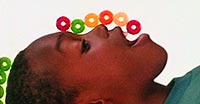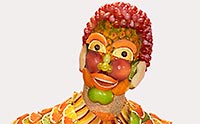Stop-Motion Chroma Key Compositing
Since the invention of motion pictures, many filmmakers have aimed to combine animation with live action. One successful method to achieve this is the chroma key technique. This process removes a color background, typically blue or green, by electronically cutting out the foreground subject, which is then composited over a different image. Chroma key works particularly well with stop-motion animation. Chiodo Bros. Productions in Burbank, California are experts in this technique. In the 1990s, I worked as an animator on several Chiodo Brothers projects, including a Cup-O-Noodles commercial featuring a saber-toothed tiger.
Like all productions in the pre-digital era, the commercial was shot on film. The preferred chroma key color for film was blue, as the blue emulsion layer of film provided the best detail. The Chiodo Brothers' blue screen stages were painted with a special paint that created the richest blue possible, and lit with banks of fluorescent lights for even illumination. To achieve a match in perspective and lighting between the stop-motion puppet and the previously filmed background, a clip of the film was placed in the gate of the Mitchell animation camera for viewing, allowing precise alignment. The animation was supervised by Stephen Chiodo, who gave me direction on what was expected for the saber-toothed tiger's performance. Essentially, I needed to animate the saber-toothed tiger falling from a tree, hitting the ground, roaring, then chasing a family of cavemen around in a circle several times. The saber-toothed tiger puppet was superbly constructed and inspiring to animate. Incidentally, the cavemen were actually actors wearing suits with animatronic heads created by the Jim Henson Company, who also performed on a blue screen. Once the animation was completed, all compositing was performed by a high-end post-production facility, as that kind of specialized equipment was very expensive in those days. The motion of the saber-toothed tiger and the cavemen was also sped up in post-production for a more comedic effect. My animation had realistic timing originally, but speeding it up fit the wacky concept of the commercial.
In the present day, chroma key has become even more powerful thanks to modern digital cameras and compositing software. Green is now the color of choice, as the green channel in digital cameras has the least amount of noise, resulting in the cleanest separation. Aligning the subject with the background image is much easier now that the two images can be viewed together on a computer, allowing close interaction if needed. Expensive post-production facilities are no longer necessary; compositing can be done on a computer with readily available software with greater control and accuracy than ever before. Additionally, realistic motion blur can be added to stop-motion animation in post-production using software such as ReelSmart Motion Blur. Currently, stop-motion/live action films are considered obsolete and marginalized by more "realistic" computer animation. However, the use of stop-motion with chroma key compositing and added motion blur is a winning combination and provides a unique alternative to the commonplace appearance of computer-generated effects.
Here are some behind the scenes photos of the bluescreen stages at Chiodo Brothers Productions in the early nineties...










































